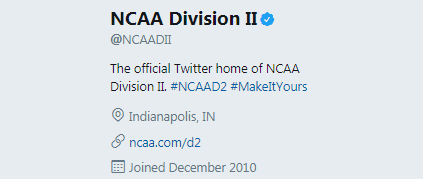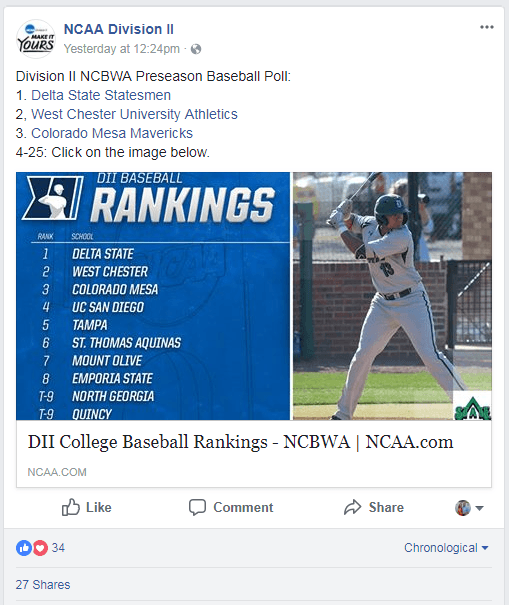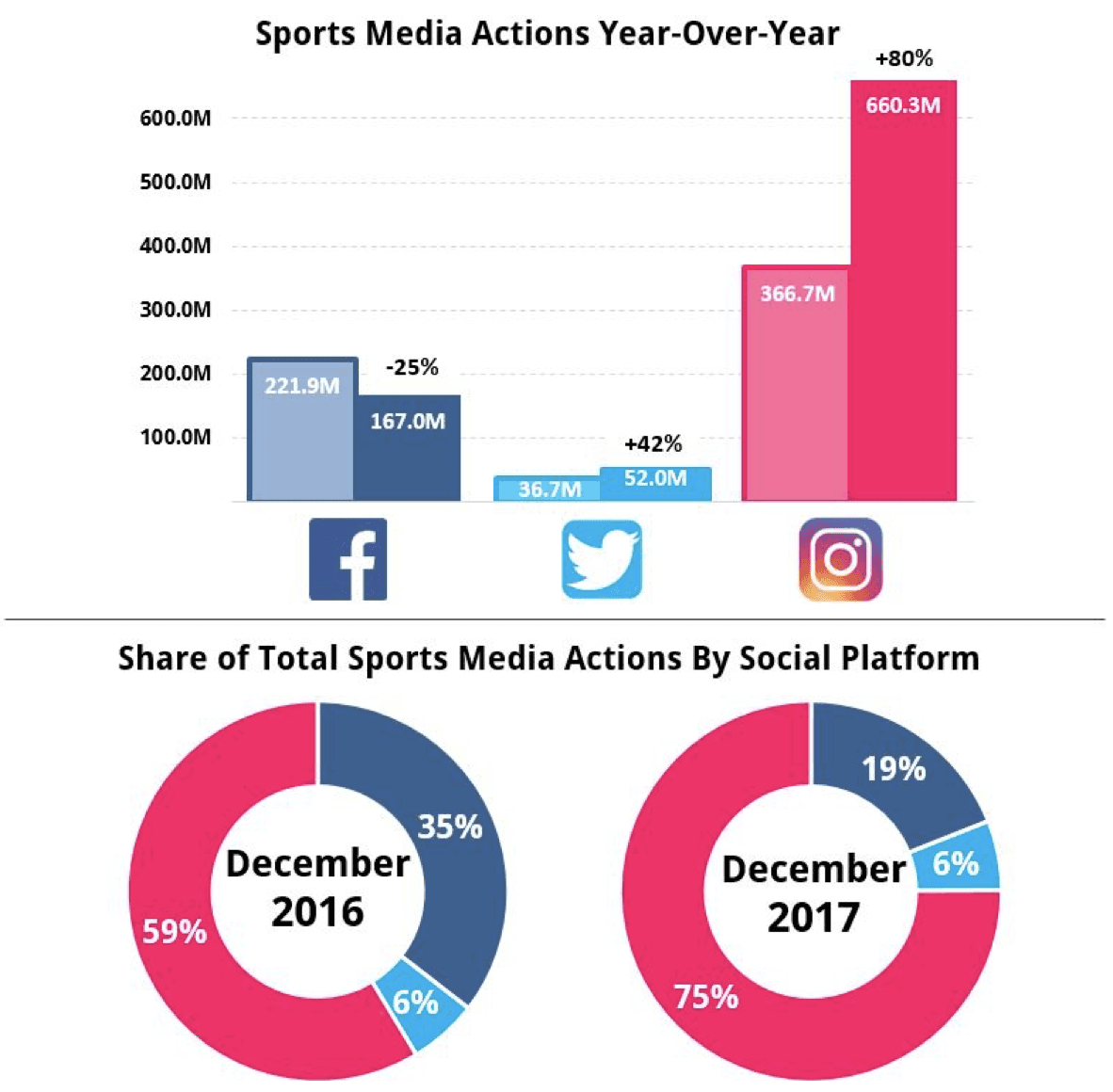Three Keys to Improve Your Social Media Presence
Simple Social Media Strategies for Small College Athletics
Jeff Mason, Athletics Development Officer
University of Central Missouri
According to Domo , every minute in 2017 produced more than 46,000 posts to Instagram. Meanwhile, over 450,000 tweets were sent while another 525,000+ snaps were sent. While all pales in comparison to the 4 million likes that Facebook users generate every 60 seconds.
In a small department, keeping up with social media feels impossible. But it doesn’t have to. First things first: What do you want to accomplish? What is your goal? If you’re caught in the rat race attempting to match the output of a major program (with a larger budget, more resources, and more staff), then yes: It’s going to feel impossible. But if you take the time to analyze what you can (and cannot) do well and consistently , you can lay out a plan to move forward and grow your accounts.
Whether you’re sharing social media duties across a number of people (media relations, coaches, graduate assistants, etc.) or handling it on your own, I’ve got a few things to look at that can help your program elevate the social media game. For this post, I’m focusing on our primary three: Facebook, Twitter, and Instagram.
HELP PEOPLE FIND YOU
The first time a potential student-athlete searches for your department’s Twitter account, how hard will they have to look? Is your institution’s name or abbreviation in the handle? Is your profile picture your primary logo? When it comes to growing an account, ‘discoverability’ matters.
(1) Clean up your account handles and find some consistency
When a user attempts to find your accounts, the two quickest sources are your display name (‘NCAA Division II’ in this image) and the handle itself (@NCAADII). In a search, users can also find you through tags in your profile (#NCAAD2 and #MakeItYours, for example) on Twitter and Instagram.
·How To Change Your Twitter Name: Twitter.com Help
·How To Change Your Facebook Page’s Name: Facebook.com Help
·How To Change Your Instagram Name: Instagram.com Help
At Central Missouri, we have a primary department account in addition to team accounts. Streamlining our accounts into a more uniform approach is going to be a major project for this summer as we push more of our resources online (we eliminated media guides last year due to budget cuts and now maintain record books on our website). Portland State is an excellent example of a department who recently took this step. All of their team accounts now start with ‘psuviks’ on Twitter and are paired with sport abbreviations to produce the following: @psuviksWSCOC, psuviksFB, psuviksMBB, and so on.
Video Reveal: https://twitter.com/psuviks/status/947386225039572992
This is one tip that requires a time investment upfront, but pays off in the long run. One important note: Time this out if you have existing materials (print, sponsor signage, etc.) with your current handles. This may require a financial investment and, if so, should be planned out accordingly.
(2) Utilize tags and lists
Particularly on Facebook, tagging other pages is a great way to direct traffic – particularly as the platform continues to trend towards pay-to-play modeling in the NewsFeed. Otherwise, the primary form of pushing your page into a user’s stream is going to be through a sponsored post.
This is particularly useful when you’ve got coaches or someone else outside of your media relations staff handling team accounts. In a story posted on the main account about the new baseball poll, tagging the baseball team’s page can send a notification to the account administrator. It’s an easy way to put the ball in their court about sharing the material without a constant stream of text messages, e-mails, or phone calls.
Twitter and Instagram can be treated in a similar way, whether the tags are applied in the text of a post or tagging the photo. Not only do these serve as a notification for the handler of an account you’re tagging, but they also provide a direct path to your other accounts.
With a Twitter List, you can compile all of the accounts into one spot – easy to find and use for your fans. These lists are great links to push at the start of a new academic year, a new semester, or the start of a season for a team.
STAY IN THE CONVERSATION
(1)
Use free scheduling tools to spread your posts across different times
Personally and professionally, I rely on scheduling daily. When a basketball game goes to overtime and I know some of our fans are already asleep, scheduling allows me to make sure the recap is going to repost the next morning without my full attention. That’s the bottom line of why you should embrace scheduling posts on social media: You can spend a designated amount of time to get material ready for the next 5+ days. With our baseball season beginning this week, I scheduled out the week’s worth of posts on Monday. Rather than log in to the accounts each day, I was able to spend a little over an hour on Monday to make sure we were posting multiple times a day in the buildup to a new year.
·Schedule a post on Facebook: Facebook.com Help
·About Tweetdeck ( Tweetdeck 101 ) and how to schedule a tweet: Twitter.com Help
·Hootsuite recently added scheduling for Instagram: Hootsuite Help
Your students who support your teams and the community fans have very different schedules. Scheduling posts to reach both (in very different time slots) often takes just a few moments after the original.
(2) Embrace Instagram Stories
The only thing that is still chronological on Instagram: Stories. As the feed for normal posts has moved to an algorithm, the strategy for Instagram has shifted. The posts about your team’s win may not be seen by a user for days with the change in how the feed distributes posts. To accommodate that change, more teams are turning to Instagram Stories for more real-time updates. Mirroring the Snapchat Story feature, a post will disappear after 24 hours.
At Central Missouri, we’re using these in a few ways including building awareness for upcoming events (“Mules Basketball takes on Central Oklahoma tomorrow night”) and post-game with a final score. Typically, these posts are just a student-athlete action shot that has been cropped.
With just under 4,000 followers on our department’s Instagram account, each post to our Instagram Story is averaging over 1,300 views. When I add a location tag ( read more about those here ), that number is getting a bump to 1,600+ on a regular basis.
�>2One more major note on Instagram: Switch your department’s account to a business profile ( here’s the how-to from Facebook ) for enhanced features like the ability to add an e-mail or call button to your profile as well as some analytics on your posts. Included in those analytics: Your impressions over the last seven days (broken down by day), basic demographics on your followers (age and location), and most importantly: When your followers are scrolling through Instagram.
(3) Repurpose and reuse
To build off the point about scheduling: There is no reason to only get one post out of a story. A big win, a major highlight, a solid move in the polls – they’re all stories your fans want to see. Change your caption a bit to take a different angle and draw a different crowd of engagement. Whereas the initial post about the team win draws likes, comments, and shares from your main fan base, a repurposed post highlighting your student-athlete’s new career achievement could extend that into family and friends who wouldn’t have otherwise seen the post.
If your department has a growing number of photos from events, consider that a bank of content. If you’re only using a picture to serve as the lead image for your game recap, you’re robbing yourself of potential on future posts. If you’re in need of inspiration or some baseline examples, check out the #SMsports (social media + sports) tag on Twitter.
ACTIVATE YOUR ECOSYSTEM
This is a line I cite often and it comes from Nick Marquez (@Quezzymoto ) who works in sports partnerships for Facebook. What does it mean? Every individual and organization around you on campus – from your students to the Dining Hall – can impact your social media presence. It’s up to you to integrate them.
Start by reaching out across campus – first with administrative departments and then to educational departments. If your university has a designated, in-house marketing team, they’re likely utilizing social media tools for planning, distributing, and analyzing content. A partnership across campus can open up these tools for your department to enhance your online presence without adding the cost typically associated with these ‘corporate’ tools. From there, check in with educational programs where you can find a mutually beneficial crossover. Whether it’s photography students bolstering the amount of pictures you’ve got or a communications student who can help you with copy, there are individuals who are looking for meaningful experience.
The final point: The most important asset you have at your disposal in social media is the people . Your coaches and student-athletes love the game, live for the moments, and create the memories for your fans. Empower your student-athletes to be a part of your social media messaging by serving as a carrier. Make no mistake: It’s not an easy task. It’ll take time, trust, and effort from both sides. But embracing your students and coaches as the key to reaching people will take your accounts further than a press release ever could.





